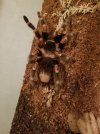SpiderSteve
New Member
- Messages
- 5
- Location
- Philadelphia, PA
So I recently picked up a Brachypelma Hamorii from my local pet store. It has a big bald spot on its abdomen, which I think can be a sign of being in pre molt, but it was also flicking a lot of hairs the day I got it, which can cause the bald spot I know too.
The pet store, I've come to understand after doing a lot of my own research after getting my first tarantula, is actually pretty clueless when it comes to taking care of these things. It's actually sad when I see the conditions in which some are kept. When I got my b hamorii, the substrate was beyond wet. There was no hide, and hardly a water dish. The point I'm making is that this was definitely one stressed out T, because the first week I had it, it drank water like crazy. I upgraded him to a more fitting habitat after a week, and during the process it was much more calm and not even flicking hairs, completely unlike its behavior the day I got it (the lady even reached into the habitat to "give it a pet one last time" as the T is visibly being defensive and freaking out).
Now my real question/concern here is - the day I got it, about 3 or 4 weeks ago, the lady said it at 5 crickets the day before. Which seems to be a lot I think if this T is in pre molt? However, it refuses food whenever I try to feed it, but I'm not sure if I should even be trying to feed it. My only other T hasn't even molted in my possession yet and is on a nice one a week feeding schedule of 1-3 crickets or a super worm. I don't know if my b hamorii was just stressed from being at a not very good pet store for tarantulas and I should start trying to find a feeding schedule, or if it is in fact in pre molt and I should just leave it alone and make sure it has water and all that.
Sorry for the long post, I'll include some pictures here. I have no idea how old it may be.
The pet store, I've come to understand after doing a lot of my own research after getting my first tarantula, is actually pretty clueless when it comes to taking care of these things. It's actually sad when I see the conditions in which some are kept. When I got my b hamorii, the substrate was beyond wet. There was no hide, and hardly a water dish. The point I'm making is that this was definitely one stressed out T, because the first week I had it, it drank water like crazy. I upgraded him to a more fitting habitat after a week, and during the process it was much more calm and not even flicking hairs, completely unlike its behavior the day I got it (the lady even reached into the habitat to "give it a pet one last time" as the T is visibly being defensive and freaking out).
Now my real question/concern here is - the day I got it, about 3 or 4 weeks ago, the lady said it at 5 crickets the day before. Which seems to be a lot I think if this T is in pre molt? However, it refuses food whenever I try to feed it, but I'm not sure if I should even be trying to feed it. My only other T hasn't even molted in my possession yet and is on a nice one a week feeding schedule of 1-3 crickets or a super worm. I don't know if my b hamorii was just stressed from being at a not very good pet store for tarantulas and I should start trying to find a feeding schedule, or if it is in fact in pre molt and I should just leave it alone and make sure it has water and all that.
Sorry for the long post, I'll include some pictures here. I have no idea how old it may be.

